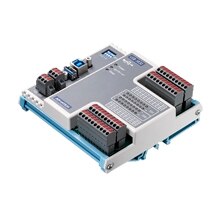Today I was approached about roadtesint this USB 3.0 I/O Module. so, I wanted to take a moment to introduce it to you, mention a few salient points, and ask the RoadTester group how they would roadtest it. Here goes:
This is a 16-channel isolated digital input and output USB 3.0 I/O module. It has a built in USB hub that supports a daisy chain topology. All digital input and digital output channels are protected by 2,500 VDC isolation. A few other points are:
- USB 3.0 SuperSpeed
- Daisy chainable by built in USB hub
- 16-ch digital input and 16-ch digital output with 2,500 VDC isolation
- Wide input voltage range (10 ~ 30 VDC)
- Wide output voltage range (5 ~ 40 VDC) and high output current (350 mA/ch)
- Quick removable European type connector
- LED indicators for I/O status
- Supported operating systems: Windows XP/7/8/10 and Linux
Would you be interested in RoadTesting this product? What would you like to test or build?


